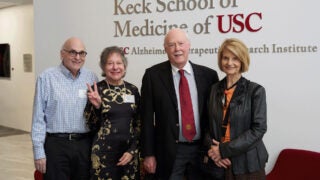How to bring solar power to the masses
USC Viterbi engineer may have the silver bullet that could make solar energy more efficient and affordable
If Rehan Kapadia succeeds at his job, you could power your home with solar energy for the price of a refrigerator.
How will the USC Viterbi School of Engineering assistant professor achieve this feat in the seemingly intransigent economics that drive Moore’s law — ever smaller, ever faster, ever cheaper — to the end of the roadmap?
Kapadia wants to shake things up: “It starts from a fundamental question — how do we make materials more scalable and low cost but also state of the art?”
Low cost, high performance
The engineer in the Ming Hsieh Department of Electrical Engineering recently received the Air Force Office of Scientific Research Young Investigator Award to develop an innovative way to generate beams of electrons by carefully controlling how photons interact with materials. If successful, the strategy could have far-reaching impacts in a diverse set of fields, from medical science to space exploration and even defense applications.
Kapadia hopes that his research will enable new classes of low-cost, high-performance devices ranging from energy generation to sensing to information processing.
Falling costs
Remember that tiny strip on your pocket calculator? For some of us, that was the most likely place to glimpse solar in action in the 1980s. Today, solar panels dot the rooftops in suburbia. Fly over Germany, for instance — currently the world’s second-biggest user of photovoltaic panels — and you’ll see shining burgs, great rivers of energy flowing with electrons.
Much of that rise is due to the falling costs of hardware, but market barriers, grid integration challenges and non-hardware “soft costs” such as permitting, financing and customer acquisition continue to keep many households out of the sun’s reach. These fees make up roughly 64 percent of the cost of a residential system, reflecting the resistance of power companies with centuries-old technology and threatened profits. In the United States, the Department of Energy reported that from 2006 to 2013, the number of homes with solar grew by an astounding 1,000 percent. The DOE estimates that some 3.8 million homes will be solar powered by 2020.
Maintain momentum
The White House is determined to sustain this momentum. In his “New Strategy for American Innovation” outlined before Congress in the State of the Union Address, President Obama pledged, “The United States will double the pace at which we cut carbon pollution.”
As intriguing as this sounds, Obama emphasized that technological advances and innovative solutions are still needed to increase efficiency, drive down costs and enable utilities to rely on solar for baseload power.
When Kapadia says state of the art, he means the highest speed transistors, world-record solar cells and lasers made from expensive processes.



